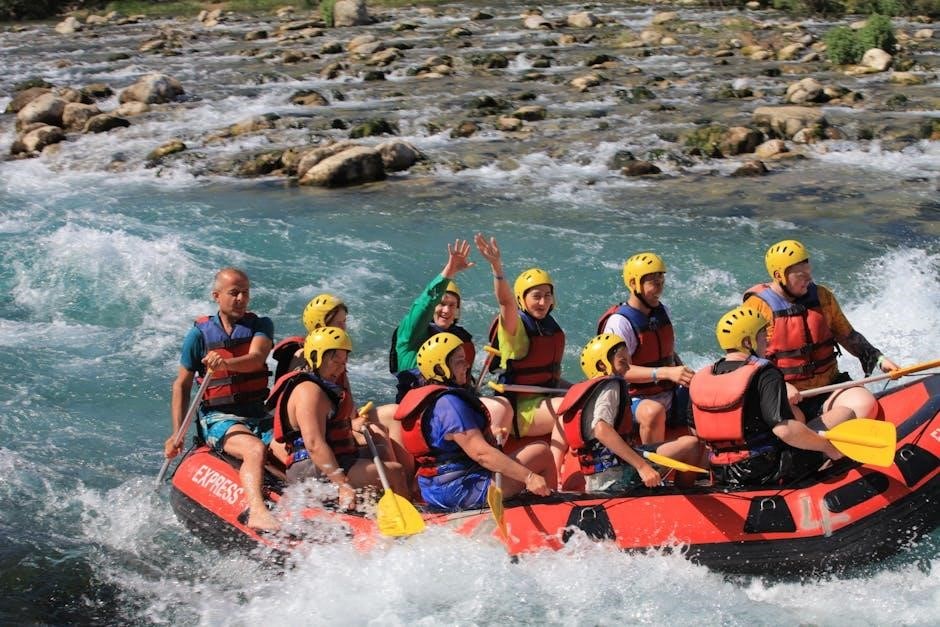Tipping raft guides is a customary way to show appreciation for their expertise, safety focus, and effort in enhancing your rafting experience. It reflects gratitude for their hard work and dedication, ensuring a memorable adventure. Guides rely on tips as part of their income, making your generosity a meaningful acknowledgment of their service.
1.1 Why Tipping is Important in the Rafting Industry
Tipping is crucial in the rafting industry as it reflects appreciation for guides’ expertise, safety focus, and effort in creating a memorable experience. Guides often rely on tips as a significant part of their income, ensuring high-quality service and dedication. Tipping also supports the guides’ ability to maintain equipment, undergo training, and provide exceptional customer care. It fosters a positive environment, encouraging guides to deliver outstanding adventures while ensuring the sustainability of rafting operations.
1.2 The Role of Raft Guides and Their Impact on Your Experience
Raft guides are essential to your adventure, ensuring safety, navigating challenging rapids, and providing expert knowledge about the environment. Their expertise enhances your experience, making the trip both exhilarating and educational. Guides also manage equipment, handle emergencies, and create a positive atmosphere. Their dedication directly impacts the quality of your rafting experience, making them indispensable to a successful and enjoyable journey on the water.

Average Tip Amounts for Raft Guides
Tipping raft guides typically ranges from 8-10% of the trip cost, with half-day trips averaging $3-5 per person, full-day trips $5-7, and multi-day trips $10-15.
2.1 Half-Day Trip Tipping Guidelines
For half-day rafting trips, tipping $3 to $5 per person is standard, depending on the service quality. This amount reflects the guide’s effort to ensure safety and an enjoyable experience. Some opt for percentage-based tipping, around 8-10% of the trip cost. For example, a $50 half-day trip might warrant a $4 to $7 tip per person. Guidelines suggest adjusting based on the guide’s performance and group size.
2.2 Full-Day Trip Tipping Recommendations
For full-day rafting trips, tipping $5 to $7 per person is recommended. This reflects the guide’s extended effort and commitment to providing a safe, enjoyable experience. Some opt for percentage-based tipping, around 10-15% of the total trip cost. For example, a $100 full-day trip might warrant a $10 to $15 tip per person. Adjustments can be made based on exceptional service or group preferences, ensuring fairness and appreciation for the guide’s work.
2.3 Multi-Day Trip Tipping Standards
For multi-day rafting trips, tipping $10 to $15 per person is commonly recommended. This amount reflects the guide’s extended involvement, including meal preparation, safety oversight, and overall trip management. Some participants opt for a percentage-based approach, tipping 10-15% of the total trip cost. Personal satisfaction with the experience often influences the final amount, ensuring the tip fairly compensates the guide for their multi-day dedication and service.

Factors Influencing Tip Amounts
Trip duration, rapid difficulty, and group size significantly influence tipping amounts. Guest satisfaction with safety, guidance, and overall experience also plays a crucial role in determining gratuity.
3.1 The Duration of the Rafting Trip
The length of your rafting adventure directly impacts tip amounts. Half-day trips typically see tips of $3 to $5 per person, while full-day excursions may range from $5 to $7. For multi-day trips, the recommended tip increases to $10 to $15 per person, reflecting the extended time and effort guides invest in ensuring a safe and enjoyable experience for all participants.
3.2 The Difficulty Level of the Rapids
The difficulty of the rapids influences tip amounts, as more challenging routes require greater skill and effort from guides. On calmer waters, a tip of 10-15% of the trip cost is standard. For intermediate rapids, 15-20% is appropriate, while extreme or technical routes may warrant 20-25%. This reflects the heightened expertise and physical demands placed on guides navigating tougher terrains, ensuring a safer and more exhilarating experience for rafters.

3.3 The Size of Your Rafting Group
The size of your rafting group can influence tip amounts. Larger groups may tip per person, while smaller groups might base tips on a percentage of the total cost. For example, a half-day trip might see $5-10 per person, while smaller groups could tip 15-20% of the total. This ensures fairness and reflects the guide’s effort in managing the group’s safety and experience, regardless of the group’s size.

Regional Tipping Etiquette
- Larger groups may tip $5-15 per person for half-day trips.
- Smaller groups often tip 10-20% of the total cost.
- The guide’s effort remains consistent, so tips should reflect group size fairly.
4.1 Tipping Norms in the USA
In the USA, tipping raft guides is customary and typically ranges from 10% to 20% of the total trip cost. For half-day trips, $3-5 per person is standard, while full-day trips often see $5-10 per person. These amounts reflect the guide’s role in ensuring safety and enhancing the experience. Tipping practices in the US are consistent with service industry standards, where gratuity is expected and appreciated for exceptional service.

4.2 Tipping Customs in the UK
In the UK, tipping customs for raft guides differ from the USA. While not expected, tipping is appreciated for exceptional service. Typical gratuities range from 5-10% of the trip cost or £5-10 per person for half-day trips. These amounts reflect the guide’s role in ensuring safety and enhancing the experience. Tipping practices are less formal but still valued in the UK, aligning with the service quality provided.
4.3 Tipping Practices in Other Countries
Tipping practices for raft guides vary significantly across countries. In some regions, tipping is not expected but appreciated, while in others, it is customary. For example, in Japan, tipping is generally not practiced, while in New Zealand, tipping is optional but welcomed for exceptional service. In many emerging destinations, tipping amounts may be influenced by local customs or economic conditions, reflecting the cultural norms of the area. Always research local tipping etiquette beforehand to ensure appropriateness and respect for traditions. Tipping practices can differ widely, so understanding regional expectations is key to showing gratitude appropriately. Tipping customs outside the USA and UK often blend traditional practices with modern influences, creating a diverse landscape for gratitude expression. Recognizing these differences ensures a respectful and enjoyable experience for both guests and guides. Tipping practices in other countries require awareness of local norms to avoid misunderstandings and demonstrate appreciation effectively. Tipping customs vary globally, so it’s essential to adapt to regional expectations when considering gratuities for raft guides. Tipping practices in other countries may differ significantly from what is customary in the USA or UK, so researching local norms is crucial. Tipping customs in other countries often reflect cultural values and economic conditions, making it important to understand regional expectations before your trip. Tipping practices in other countries may not always align with American or British standards, so being informed ensures a smooth and respectful experience. Tipping customs in other countries can vary widely, so it’s important to research local expectations to show appreciation appropriately. Tipping practices in other countries may differ significantly, so understanding regional customs ensures a positive experience. Tipping practices in other countries often have unique traditions, so adapting to local expectations is key. Tipping customs in other countries may not always align with what is expected elsewhere, making research essential. Tipping practices in other countries require consideration of local norms to ensure a respectful experience. Tipping customs in other countries may vary widely, so understanding regional expectations is crucial. Tipping practices in other countries often reflect local traditions, so being informed ensures a smooth experience. Tipping customs in other countries may differ significantly, so adapting to regional norms is important. Tipping practices in other countries require awareness of cultural differences to show gratitude appropriately. Tipping customs in other countries may not always align with American or British standards, so understanding local expectations is essential. Tipping practices in other countries often blend tradition and modern influences, creating diverse customs. Tipping customs in other countries may vary widely, so researching regional expectations ensures a respectful experience. Tipping practices in other countries may not always align with what is expected elsewhere, making local research essential. Tipping customs in other countries often reflect cultural values, so understanding regional norms is key. Tipping practices in other countries may differ significantly, so being informed ensures a positive experience. Tipping customs in other countries may not always align with American or British standards, so adapting to local expectations is important. Tipping practices in other countries require consideration of cultural differences to ensure a respectful experience. Tipping customs in other countries may vary widely, so understanding regional expectations is crucial. Tipping practices in other countries often blend traditional practices with modern influences, creating diverse customs. Tipping customs in other countries may differ significantly, so researching local norms is essential. Tipping practices in other countries often reflect local traditions, so being informed ensures a smooth experience. Tipping customs in other countries may not always align with what is expected elsewhere, making local research essential. Tipping practices in other countries require awareness of cultural differences to show gratitude appropriately. Tipping customs in other countries may not always align with American or British standards, so understanding local expectations is essential. Tipping practices in other countries often blend tradition and modern influences, creating diverse customs. Tipping customs in other countries may vary widely, so researching regional expectations ensures a respectful experience. Tipping practices in other countries may not always align with what is expected elsewhere, making local research essential. Tipping customs in other countries often reflect cultural values, so understanding regional norms is key. Tipping practices in other countries may differ significantly, so being informed ensures a positive experience. Tipping customs in other countries may not always align with American or British standards, so adapting to local expectations is important. Tipping practices in other countries require consideration of cultural differences to ensure a respectful experience. Tipping customs in other countries may vary widely, so understanding regional expectations is crucial. Tipping practices in other countries often blend traditional practices with modern influences, creating diverse customs. Tipping customs in other countries may differ significantly, so researching local norms is essential. Tipping practices in other countries often reflect local traditions, so being informed ensures a smooth experience. Tipping customs in other countries may not always align with what is expected elsewhere, making local research essential. Tipping practices in other countries require awareness of cultural differences to show gratitude appropriately. Tipping customs in other countries may not always align with American or British standards, so understanding local expectations is essential. Tipping practices in other countries often blend tradition and modern influences, creating diverse customs. Tipping customs in other countries may vary widely, so researching regional expectations ensures a respectful experience. Tipping practices in other countries may not always align with what is expected elsewhere, making local research essential. Tipping customs in other countries often reflect cultural values, so understanding regional norms is key. Tipping practices in other countries may differ significantly, so being informed ensures a positive experience. Tipping customs in other countries may not always align with American or British standards, so adapting to local expectations is important; Tipping practices in other countries require consideration of cultural differences to ensure a respectful experience. Tipping customs in other countries may vary widely, so understanding regional expectations is crucial. Tipping practices in other countries often blend traditional practices with modern influences, creating diverse customs. Tipping customs in other countries may differ significantly, so researching local norms is essential. Tipping practices in other countries often reflect local traditions, so being informed ensures a smooth experience. Tipping customs in other countries may not always align with what is expected elsewhere, making local research essential. Tipping practices in other countries require awareness of cultural differences to show gratitude appropriately. Tipping customs in other countries may not always align with American or British standards, so understanding local expectations is essential. Tipping practices in other countries often blend tradition and modern influences, creating diverse customs. Tipping customs in other countries may vary widely, so researching regional expectations ensures a respectful experience. Tipping practices in other countries may not always align with what is expected elsewhere, making local research essential. Tipping customs in other countries often reflect cultural values, so understanding regional norms is key. Tipping practices in other countries may differ significantly, so being informed ensures a positive experience. Tipping customs in other countries may not always align with American or British standards, so adapting to local expectations is important. Tipping practices in other countries require consideration of cultural differences to ensure a respectful experience. Tipping customs in other countries may vary widely, so understanding regional expectations is crucial. Tipping practices in other countries often blend traditional practices with modern influences, creating diverse customs. Tipping customs in other countries may differ significantly, so researching local norms is essential. Tipping practices in other countries often reflect local traditions, so being informed ensures a smooth experience. Tipping customs in other countries may not always align with what is expected elsewhere, making local research essential. Tipping practices in other countries require awareness of cultural differences to show gratitude appropriately. Tipping customs in other countries may not always align with American or British standards, so understanding local expectations is essential. Tipping practices in other countries often blend tradition and modern influences, creating diverse customs. Tipping customs in other countries may vary widely, so researching regional expectations ensures a respectful experience. Tipping practices in other countries may not always align with what is expected elsewhere, making local research essential. Tipping customs in other countries often reflect cultural values, so understanding regional norms is key. Tipping practices in other countries may differ significantly, so being informed ensures a positive experience. Tipping customs in other countries may not always align with American or British standards, so adapting to local

When to Tip Your Raft Guide
The best time to tip your raft guide is at the end of the trip, typically during farewell or when returning to the base. Express gratitude personally, ensuring the guide receives your appreciation directly. Tipping earlier can motivate exceptional service, while tipping after allows you to reflect on the entire experience. Either way, ensure your gratitude is conveyed sincerely and appropriately.
5.1 The Best Time to Present the Tip
The best time to present a tip to your raft guide is at the conclusion of the trip. For half-day or full-day excursions, this is typically when you return to the base. For multi-day trips, the last evening or morning before departure is ideal. Presenting the tip directly to the guide ensures they receive your gratitude. Timing your tip appropriately shows appreciation for their efforts and enhances the positive experience for both parties.

How to Tip Raft Guides Appropriately

5.2 How to Appropriately Present the Tip
When presenting a tip to your raft guide, it’s important to do so thoughtfully and respectfully. Consider handing the tip directly to the guide, ensuring they receive it personally; Cash is the most common method, but some may accept digital payments if arrangements are made in advance. Expressing gratitude verbally can enhance the gesture, showing genuine appreciation for their efforts. Always check if the company has specific tipping policies or preferences to ensure compliance.
